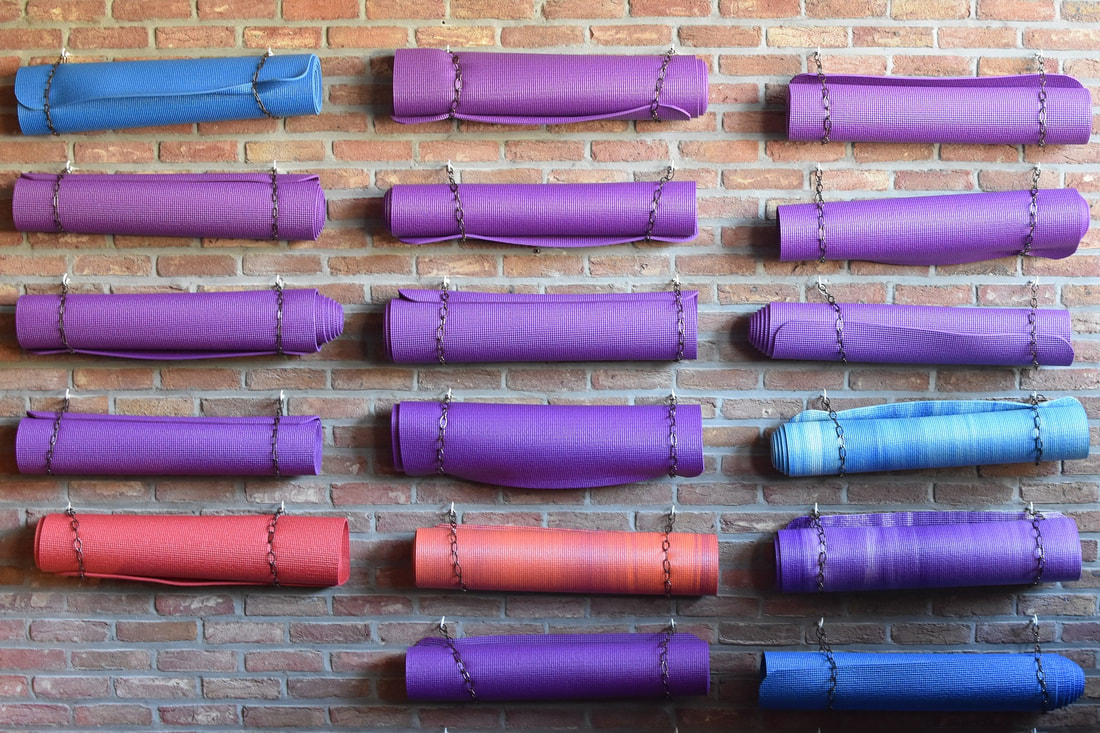|
12/11/2019
Meet your mat(ch)!
Before purchasing your first mat, you will want to consider the following criteria. Each of these are discussed in depth in this blog. Check list of criteria before purchasing your first yoga mat
What type of yoga do I practice? Whether you are new to yoga or not, it is important to know that your yoga practice will most likely evolve over time. For example, Chantal, who teaches Gentle Yoga on Tuesday evenings at the studio used to mainly practice Vinyasa Yoga and preferred a more active type of yoga. During this time, to avoid slipping and to work on more advanced postures, she practiced on a thinner mat with lots of “gripping power.” These days, her practice is more restorative. Therefore, her preference is a thicker mat with tons of “cushion power.” Eventually, you may want to own more than one mat, to support your different moods and practices. In the meantime, determine what your usual yoga practice looks like these days, and let that be your guiding light when selecting your mat. Low-Cost Options to consider before purchasing a mat Hardwood Floor You might be surprised that this is our first consideration but practicing standing balancing poses and single-legged standing poses on hardwood floor can make you feel really stable. In general, it is easier to stand and balance on a hard, solid surface rather than a thick, soft mat that caves under your weight (which is why most yoga studios have hardwood floors.) If you practice yoga and you find that you are a little shaky or wobbly while in standing poses, try them on solid ground to see if it helps. The downside to practicing yoga on a hardwood floor is that kneeling, sitting, supine, and prone postures may be uncomfortable for some people. For example, kneeling postures done without a yoga mat is definitely uncomfortable for many yoga practitioners. This can be remedied quickly by placing a blanket or towel under the knees. You also have the option of using yoga gloves and/or yoga socks that come with grippy surfaces preventing slipping. Towel Using what you have at home is a simple, eco-friendly and low-cost solution. A large towel, placed on top of a carpet for example, can be used until you’ve honed your yoga practice and feel ready to graduate to a yoga mat. To avoid slipping and sliding, please note that it is not recommended to practice yoga on a towel that is placed directly on a floor without a carpet.
Keep in mind that if you are using studio mats, chances are that several yogis have also used it before you. Although most studios make every effort to keep their mats clean, a communal yoga mat is probably not as hygienic as using your own. How much should I spend? You can pay between $20 and $100 for a mat that will last you a few years, depending on how often you practice and how well you take care of it. For example, leaving your yoga mat in the car is not a good idea as the temperature changes will affect its durability. Because the prices of yoga mats vary a great deal, determine your budget first. You can get a yoga mat from the local dollar store for as low as $4 or you can pay upwards to $100,000 USD for the most expensive leather mat ever found on the planet. No, I did not make this up for shock value. The latter does come with a lifetime warranty, but seriously, who can afford a $100,000 yoga mat and do you need it to become a yoga practitioner? Absolutely not! As Krishnamacharya said, “If you can breathe, you can do yoga.” (For those of you who are curious about this $100,000 yoga mat, I am sharing the link at the bottom of this blog.) What is your yoga mat made of? To protect your health and the environment, it is important to consider what your future yoga mat is made of. Purchasing an eco-friendly mat is, in my opinion, a must. Unfortunately, the majority of mats offered in chain stores are made of synthetic material like PVC or polyurethane. These are to be avoided at all cost. Mats made of tree rubber, recycled rubber, cork, jute, cotton and other natural fibers are better options. Cork is marketed as the more “environmentally-friendly option” and can offer a nice grippy surface. When selecting your mat, smell it! Some may smell strongly of plastic or rubber. If you are sensitive to odors or prone to headaches, the last thing you will want to do is get close and personal with your smelly mat. Mats made out of tree rubber tend to smell but the odor will eventually fade as time goes by. And, if you have deep pockets, the leather one is still on the market! It is obviously not for vegan practitioners though! They often provide more grip than hardwood. Some are super lightweight and fold away easily into a backpack or carry-on for trips. If you tend to use public transportation to get to and from yoga, it might be a good idea to invest in one of these because it greatly reduces bulk and weight on crowded buses and trains. You can improve the experience of a thin mat by using yoga props, which are offered at most studios. For example, if kneeling down on a thin mat is uncomfortable, slip a folded blanket or towel underneath your knees for extra support. Thicker mats are great if you like the added comfort and/or have sensitive joints. They are ideal when practicing gentle or restorative yoga where most of the postures are kneeling, supine, or prone. They also make for luxurious savasanas! I prefer to keep thicker mats for my home practice because they can get quite heavy to carry around. Gripping power The gripping power of a mat can help support your practice - or work against it. When purchasing your mat, make sure it is not a slippery one to begin with. There is nothing worst than being in Downward Dog and feel your hands and feet slip on the mat! When this happens, your attention is suddenly taken away from your intention and directed towards the fact that you are sliding all over the place. Make sure that the gripping power of your mat corresponds to your needs. Believe it or not, too much grip can also be a hindrance for some people who tend to “drag” their toes or feet when transitioning from one posture to the next. If the transition is done quickly, the grip can “stop you dead” in your movement and all sorts of unfortunate scenarios can unfold. In general, a super grippy mat is ideal for experienced yoga practitioners who love their hot yoga, and who sweat a lot. That’s not to say that gripping power is less important for others. However, for people who solely practice slow, gentle, restorative yoga, the level of gripping power is not as necessary. Some newly purchased mats may be slippery right “out of the box.” This could be due to a surface spray from the factory and can easily be rectified at home. Take a spray bottle and fill a quarter of it with vinegar and the rest with water. Spray your new mat with this vinegar solution, wipe it down and wait for it to dry. You may need to do this a few times to get rid of the slippery coating. A special note on stretchy mats! Beware of mats that stretch as you practice. This can happen not only with poor quality mats, but also with older mats and with Pilates mats, as well as exercise mats. If you have an older mat that starts stretching after years of practice, it is time to buy a new one. If a mat looks or feels stretchy in the store, it is most likely designed for another activity. Stretchy mats can unfortunately lead to slipping and possible injuries. So be safe and avoid stretchy mats. Sizing and Shape The most common shape is rectangular, but there are surf-board-shaped yoga mats, as well as circle-shaped mats. This is totally up to personal preference, personal expression, and perhaps whether or not you practice paddle-board-yoga! If you strictly practice in a yoga studio, a rectangular yoga mat is the way to go, unless specified otherwise. To avoid having your feet and head “hang out” directly on the floor, make sure that the mat you select is long enough and wide enough for you. Luckily, some companies have started making longer and wider mats for taller practitioners, so there are lots of choices no matter your body size. Colour Yoga mats come in a rainbow of colors. You can choose one that makes you happy, or one that makes you feel calm, or one that makes you feel energized. Color psychology is important! For example, green is soothing while red is energizing. When selecting the color of your mat, take into consideration the intention of your yoga practice and consult the following study on colors and how they make most people feel: https://www.colorpsychology.org). As a final note on colors, I would suggest sticking with darker shades, simply because lighter colors feature stains more prominently. I have personally owned a spectrum of colors and regardless of wiping them down after every use, the darker ones still look new while the lighter colors look “well-loved”, to put it diplomatically! Conclusion Choosing a yoga mat can be extremely subjective. When making the decision, don’t rush, take some for a “test drive” if possible, and use the checklist of criteria I provided at the beginning of this blog. Most importantly, keep your health and the environment at the forefront of your decision, and try as much as possible to purchase an eco-friendly yoga mat. Yoga mats can be found on-line, at specific yoga gear distributors. You can also find them in large department stores, certain yoga studios, and/or sporting goods stores. If you would like me to recommend my personal top choice and where I purchased my mat, feel free to connect with me after class! CLASS SCHEDULE I hope this information will help you find your mat(ch) soon!
Comments are closed.
|
Get the scoop!Subscribe below to receive our Monthly Newsletter
Blog archives
June 2024
Categories
All
|
Covid update
Covid 19 Update













